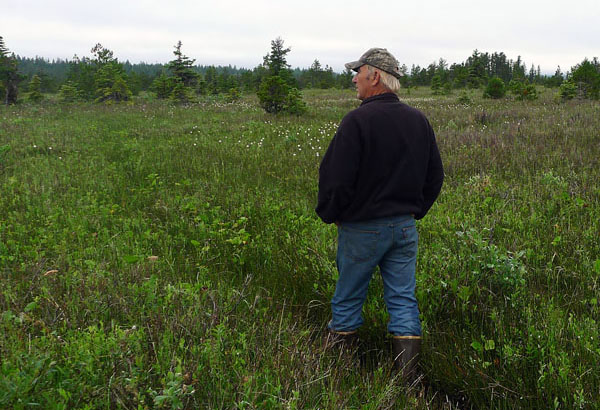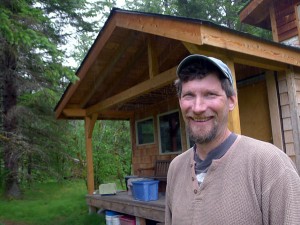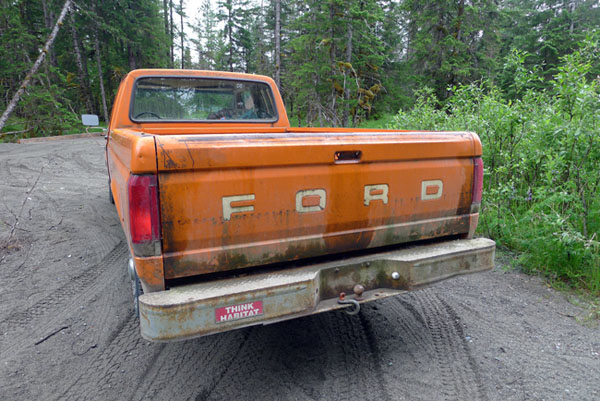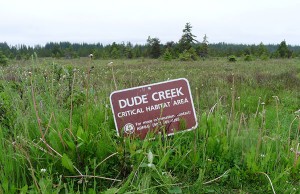
If you take a walk through the wetlands around Gustavus in the fall, it’s hard to hear yourself over this noise of thousands of sandhill cranes. The Dude Creek Critical Habitat Area is an important resting place on their migration route. The rest of the year, the reserve doesn’t look like much. It’s a soggy parcel of land just outside of town. But it’s special to the small community, which asked the state to protect the area 25 years ago.
Now, the cranes aren’t the only thing causing a fuss at Dude Creek. The wetlands have become an unlikely battleground in a fight that could decide how millions of acres of sensitive land in the state are managed. APRN’s Alexandra Gutierrez has this story.
In the same way that pet owners start to resemble their dogs, Hank Lentfer kind of looks like a sandhill crane. He’s a bit gangly and angular, with sharp eyes. For most of his adult life, Lentfer has been in love with the bird population and its habitat in Gustavus.
“I first came here as a high school student with a biology class from Juneau,” says Lentfer.
That was in 1983. Now, Lentfer lives in Gustavus year-round. He’s a steward for the Nature Conservancy and has a spot on an advisory group for some state habitat in Gustavus. The team’s job is to give input on how to manage the Dude Creek Critical Habitat Area to best protect the sandhill cranes that feed there during their migration.
Here’s how the planning process is supposed to go: The Department of Fish and Game’s Habitat Division sits down with stakeholders, and they go back and forth on what rules should apply to the land. Once division staff, state biologists, the Fish and Game commissioner, and — ideally — local residents are satisfied with what comes out of the meetings, the rules are then turned into state regulations.
Lentfer says it had been a collaborative process until this year.
“It was amazingly non-controversial,” says Lentfer.
The Habitat Division issued their first draft in 2011, and it was pretty standard. In tone, and level of strictness, it didn’t deviate much from the state’s other management plans. The new version that was issued this May did. A lot.
“It was totally out of the blue,” says Lentfer. “It was just — it just came in e-mail, saying ‘This is it. This is the new draft,’ radically different from the one that not only the planning team had signed off on, but all the members of the community that had been given a formal opportunity to comment. All those comments had been very thoughtfully summarized and included in that plan. And that’s all been gutted.”

The management plan had been cut in half and was covered in red edits. Whole sections on scientific research and local knowledge had been stripped. When it came to things like geological exploration or hazardous waste disposal, phrases like “will not allow” were replaced with “may allow.” Everything that was prohibited before could now be permitted on a case-by-case basis and without public notice.
Dude Creek is not desirable land for development. The ground beneath it is made of clay, and it’s hard to imagine any resource extraction or even building construction happening there. The most high stake issue the planning team had been dealing with was whether to allow four-wheelers. Alaska is full of controversial protected areas — Susitna Flats where there’s a nearby mining project, Kachemak Bay where there are jackup drill rigs, Bristol Bay where there are productive salmon streams. But Dude Creek’s just not one of them.
Lentfer says it felt like the state went from working with the community to working against it.
“It seems ironic that a plan developed in such strong collaboration with local people is being taken apart by the very state government that is trying to wiggle free from federal control.”
‘THERE’S A LOT OF RED INK’
To find out why these changes were made, I talked to Randy Bates, director of Fish and Game’s Habitat Division.
Bates has plenty of experience in land management issues. He spent more than a dozen years in the Department of Natural Resources working on coastal zone management, and he directed that program until it was dismantled. So it’s not a surprise to him now that this new plan from Habitat has put Gustavus residents on edge.
“There’s a lot of red ink in this draft, and I think it’s created a lot of public angst over what we’re doing,” says Bates.
Over the course of two hours, Bates walks me through the draft. During our conversation, he distances himself from the process.
“I didn’t have a hand in the redlining of this.”
Bates’ explanation for what happened is he gave staff his vision, and they went overboard. Still, there’s one principle he stands by when it comes to any sort of human activity.
“The idea is can we get to yes instead of can we justify no,” says Bates.
Bates says that because technology — and even the land itself — can change, he wants to move away from hard restrictions on land use that could block development decades from now. Instead of denying activity outright, he wants biologists to look at a permit application and ask:
“Is that oil and gas exploration activity or placer mining operation or gravel extraction operation, is that going to prohibit the use of that area by the cranes or the moose or the fish, the reason for its designation? If it is, Habitat’s first desire is to modify the project.”
The changes made to the Dude Creek plan aren’t just about Dude Creek. Habitat manages 32 special areas that stretch from the Bristol Bay region up to the Interior and then down to Southeast. That’s 3 million acres of land that the state set aside for ecological reasons. Only about half of the management plans for these areas have been completed.
Dude Creek happened to be the one that Habitat staff was working on when Bates called for a new approach to management. And he says that yes, some of this language is “precedent setting.”

“The concept of these changes was unfairly foisted upon Dude Creek. Dude Creek is … I mean even talked to our regional sup[ervisor], and said, ‘What kind of activities do you expect to occur out there?’ ‘Randy, I don’t expect to see much in the next 20 years. There’s probably not a lot going on. We’re going to see four wheelers. We’re going to see tree stands or wildlife viewing platforms — that’s what we’re going to see.’ We’re not going to see oil and gas operations. We’re not going to see miners out there. So, the concept of these changes has really affected a really small-focused plan, and it’s really raised a stir. If we were to implement this on the Susitna Flats, or the Redoubt Bay, or Kachemak Bay, it would have been the same sort of blow up, but this is much ado about nothing in this plan in many ways. It affects these other plans to a much greater extent.”
Part of why Lentfer and other Gustavus residents are troubled by this new approach is that it’s coming at the same time the Parnell administration is making an aggressive push to reform permitting. One of the governor’s big priorities is a bill that sets a higher bar for appealing a permitting decision and makes it easier for the state to issue general permits that don’t need public notice. The idea is to shrink a permitting backlog while encouraging development. But conservation groups describe the policy as an effort to limit public involvement on management decisions.
Bates says Habitat’s new permitting strategy has nothing to do with that.
“We’re not changing the planning process to exclude the public and just notify them. We still have every intention to run the process the way it was, soliciting input, sitting down, understanding the concerns. We’re not cutting anybody out of this process.”
‘UPHEAVAL’ AT HABITAT
But internal Fish and Game documents obtained by APRN contradict that statement and show even more drastic changes ahead.
As of this month, work on all new management plans, including Dude Creek, has been put on hold. Instead, Habitat has been directed to revise all completed management plans in the Dude Creek style. Rather than go through the old process — which involved public scoping meetings, collaborative interagency planning teams, and a series of comment periods — Habitat will put multiple plans into one big regulatory review packet that will go out for comment once a year.
According to an e-mail Bates sent to the division, staff cannot discuss the management changes with the public without getting his approval. Even when talking with other Fish and Game workers, they are required to report that communication and there are restrictions on what they can say. Sources within the department characterize it as a “gag order.”
The documents also show internal strife within the division. During a meeting this summer, Bates talks about staff “upheaval” and how things have gotten “relatively out of control” with the special areas planning process. During that same meeting, a staff member notes that the overhaul to the management plan process doesn’t just cut out public input — it overrides language agreed to by state biologists.
During a May meeting, a regional supervisor asks if the new planning approach is putting federal funding for two staff positions at risk, since they aren’t fully complying with requirements about public and agency engagement. That concern was again addressed during an October 22 meeting:
Mike [Daigneault, Anchorage regional supervisor] asked Randy [Bates] about funding issue, noting that the State Wildlife Grant (SWG) funding for special areas planning has specific restrictions and cannot be used to pay for the development of State regulations … He noted that SWG funding had never been used to pay for staff time devoted to adopting plans into regulation, only the collaborative inter-agency development of those plans.
Randy requested that Mike send him the SWG requirements, stating that “it may just be a creative writing exercise where we have to justify how what we’re doing now will improve communications with federal agencies down the road” …
Mike stated: “to be completely honest, Randy, given the fact that we’d be the ones charging our time, I’d have an ethical problem with that.”
Randy stated: “if I decide to go forward with it, then that’s my issue, but if you choose not to do the work, then that’s an issue you and I will have to deal with.”
In e-mails, staff question the direction to mark any document that isn’t explicitly public as “privileged and confidential,” which means someone would have to sue to get them released. (While APRN originally filed a public records request in an effort to obtain these documents, they were ultimately submitted by a source within the Department. APRN was told that the fee would exceed $2,000 and that many of the requested files would either be redacted or denied because of attorney-client privilege.)
Fish and Game Commissioner Cora Campbell says the friction between Habitat staff and its leadership may be due to an internal misunderstanding of the new policies. The changes are in response to an order from the governor to make regulations more efficient, and that there’s no attempt to limit public involvement. She says the move away from prohibitions is meant to give more discretion to state biologists.
“When you have special area plans that are not flexible at all, that can become problematic,” says Campbell. “There is nothing deeper than that here. This is not anything sinister.”

‘YOU WANT TO DETERMINE YOUR OWN DESTINY’
It’s hard to think of Dude Creek as some politically fraught place when you’re actually standing in the crane flats. I’m with Morgan DeBoer, who represented the City of Gustavus on the planning team.
DeBoer helped work through some of the original questions on snow machines and hunting accessibility. He jokes that their original plan wasn’t terribly strict, even with the cranes themselves.
“You can still shoot them over there,” says DeBoer. “It’s just their habitat we’re protecting.”
DeBoer’s got more of a claim on the land than most. In the history of Gustavus, only a couple of families tried to homestead in those meadows, and they didn’t have any success.
“The first party back in the ’30s was an aunt of mine, and her nickname was ‘Dude,'” says DeBoer. “That’s why it was called Dude Creek.”
DeBoer’s kind of a dude himself. He comes from a line of prospectors, and he makes his living by operating a sawmill, a few cabins, and a nine-hole golf course that is fertilized with goose droppings.
While we’re out on the crane flats, we talk about the planning process. The changes make him nervous. DeBoer’s not worried about the near-term, because the land is so inhospitable to development. There haven’t been many user conflicts over the years, even without a formal management plan in place.
“But if there isn’t one and it’s not a real solid one with good teeth to it, you’re opened up to problems down the line is the way I see it,” says DeBoer.
Plus, he thinks it’s important for locals to shape whatever document comes out, since they’re the ones who have to live with the outcome.
As he’s telling me about the crane flats, I realize DeBoer’s kind of a funny advocate for them. The sort of things his ancestors did — homesteading, mining for gold — are exactly the kinds of activity that would be prohibited with a stricter management approach.
But at the same time, DeBoer’s position makes sense. His family ended up settling in Alaska to establish a life under their own rules.
“Yeah, you want to determine your own destiny,” says DeBoer. “You bet.”

We finish talking and spend a few minutes listening to the wind. When we leave the flats, I nearly trip on something that’s covered in grass. It turns out to be a small sign that reads “Dude Creek Critical Habitat Area” — the only indicator you’re anywhere special.
“It needs some trimming,” says DeBoer as he starts clearing the weeds. “I hope this isn’t symbolic like I’m cleaning the headstone in the cemetery, and this is the cemetery.”
After he finishes, DeBoer smiles. He’s not ready to go into mourning yet. He thinks — he hopes — this habitat should be around for a long time. He would just like a guarantee on that.
agutierrez (at) alaskapublic (dot) org | 907.209.1799 | About Alexandra




